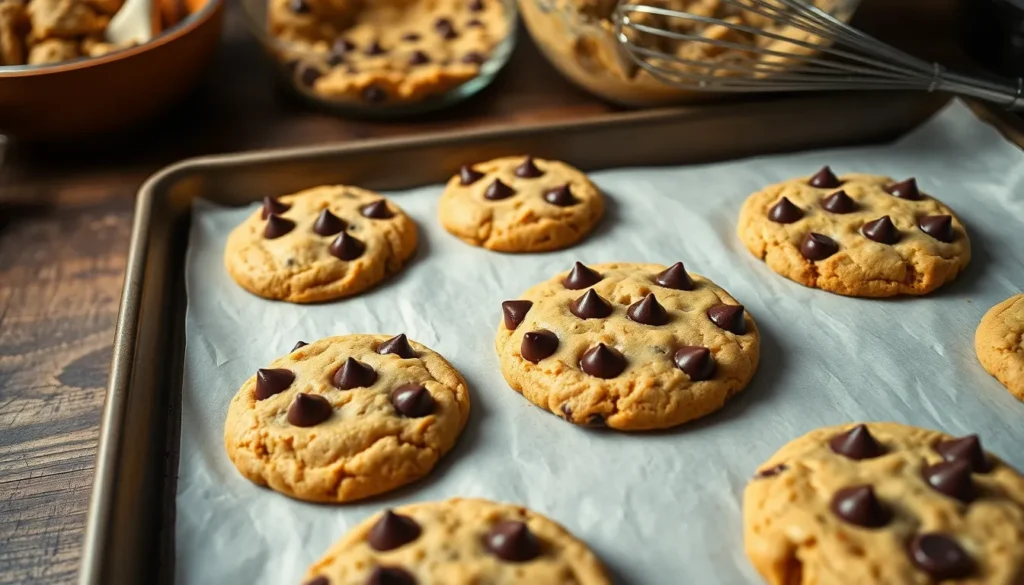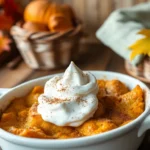We’ve discovered the secret to making perfectly chewy chocolate chip cookies without using a single egg! These eggless chocolate chip cookies deliver all the classic flavors and textures you crave while accommodating dietary restrictions and preferences. Whether you’re dealing with egg allergies, following a vegan lifestyle, or simply ran out of eggs, this recipe ensures you’ll never have to skip dessert again.
What makes these cookies truly special is how they maintain that ideal balance of crispy edges and soft centers that we all love in traditional chocolate chip cookies. The clever combination of binding ingredients creates the perfect texture while allowing the rich chocolate chips to shine through in every bite.
Ready in just 30 minutes from start to finish, these cookies prove that eggless baking doesn’t mean compromising on taste or quality. We’ll show you exactly how to achieve bakery-worthy results in your own kitchen with simple pantry staples.
Ingredients
We’ve carefully selected each ingredient to create the perfect texture and flavor balance in our eggless chocolate chip cookies. These simple pantry staples work together to deliver cookies with crispy edges and soft chewy centers.
Dry Ingredients
- 2¼ cups all purpose flour
- 1 teaspoon baking soda
- 1 teaspoon salt
- ½ cup granulated sugar
- ¾ cup packed light brown sugar
Wet Ingredients
- 1 cup unsalted butter, softened to room temperature
- ¼ cup milk (dairy or non-dairy)
- 2 tablespoons cornstarch mixed with 3 tablespoons water
- 2 teaspoons vanilla extract
Add-ins
- 2 cups semi-sweet chocolate chips
- ½ cup chopped walnuts (optional)
- 1 tablespoon flaky sea salt for sprinkling (optional)
Equipment Needed
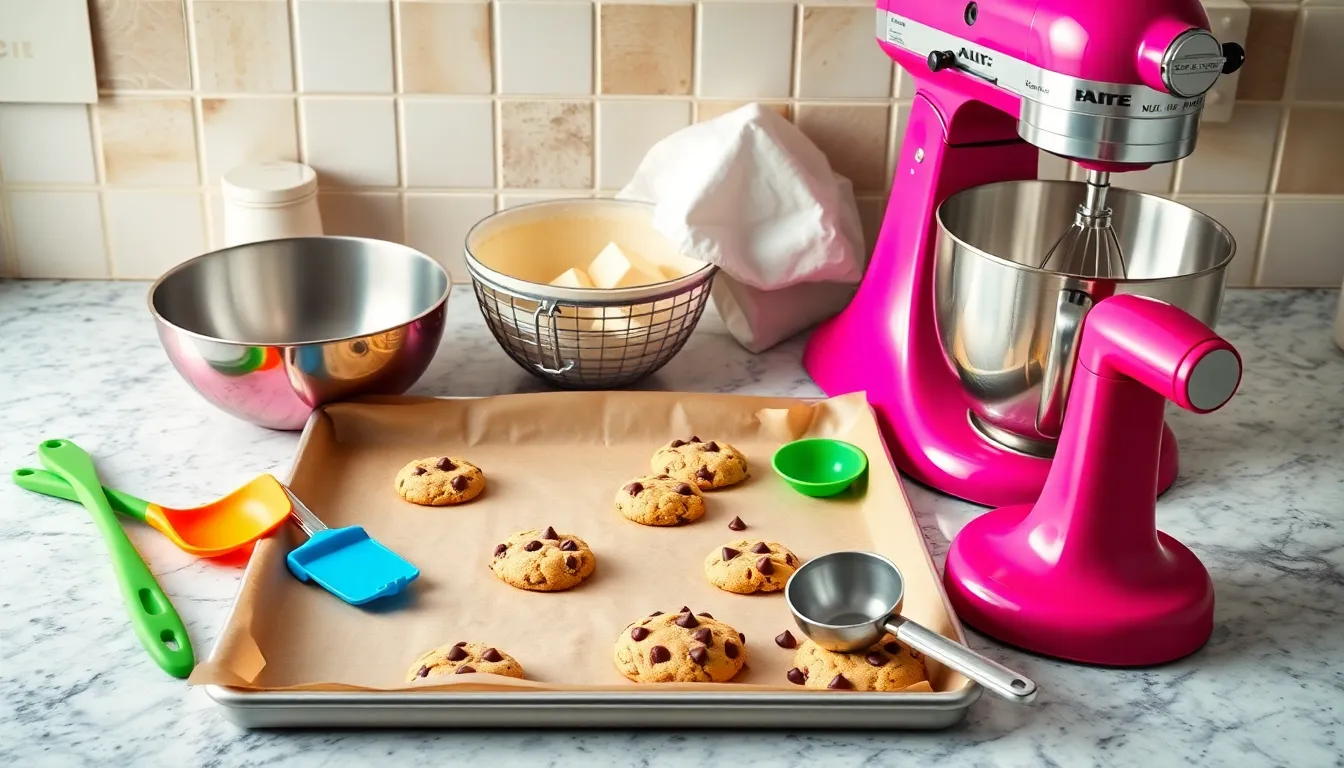
Creating perfect eggless chocolate chip cookies requires the right tools to ensure consistent results and proper texture. We recommend gathering these essential items before starting your baking process.
Large mixing bowl serves as our primary workspace for combining ingredients. A spacious bowl prevents flour from spilling and allows thorough mixing without creating a mess on your countertop.
Whisk helps us blend dry ingredients evenly and incorporates air into our mixture. This tool ensures our flour, baking soda, and salt distribute uniformly throughout the dough.
Spatula becomes crucial for folding chocolate chips into the dough without overmixing. We prefer a rubber or silicone spatula that can scrape bowl sides completely and handle thick cookie dough with ease.
Baking sheet provides the foundation for our cookies during the baking process. A heavy-duty aluminum or stainless steel sheet conducts heat evenly and prevents hot spots that could cause uneven browning.
Parchment paper creates a non-stick surface that makes cookie removal effortless. This liner also prevents cookies from spreading too much and sticking to the pan during baking.
Cookie scoop offers optional convenience for portion control and uniform cookie sizes. A medium-sized scoop (approximately 1.5 tablespoons) creates consistently sized cookies that bake evenly together.
Electric mixer can substitute for hand mixing when creaming butter and sugars together. This tool saves time and ensures proper incorporation of wet ingredients for optimal cookie texture.
Having these tools ready streamlines our baking process and helps achieve professional-quality results every time we make these delicious eggless treats.
Instructions

Now that we have our ingredients and equipment ready, let’s walk through the simple process of making these irresistible eggless chocolate chip cookies. We’ll guide you through each step to ensure perfect results every time.
Prep the Ingredients
We start by gathering all our ingredients at room temperature for optimal mixing. Remove the butter from the refrigerator 30 minutes before baking to achieve the perfect softness. In a small bowl, we whisk together the cornstarch and water until smooth, creating our egg substitute that will bind our cookies beautifully.
Measure the flour accurately by spooning it into the measuring cup and leveling it off with a knife to avoid dense cookies. We prepare our baking sheets by lining them with parchment paper and preheating the oven to 350°F (175°C).
Mix the Dough
We cream the softened butter with both granulated and brown sugars in our large mixing bowl using an electric mixer for 2-3 minutes until light and fluffy. The mixture transforms into a pale, airy consistency that forms the foundation of our cookies.
Next, we add the milk, cornstarch mixture, and vanilla extract to the creamed butter, mixing until completely combined. The mixture may look slightly curdled at first, but this is normal and will smooth out as we continue mixing.
In a separate bowl, we whisk together the flour, baking soda, and salt. We gradually add these dry ingredients to our wet mixture, mixing on low speed just until combined. Finally, we fold in the chocolate chips using a spatula, ensuring even distribution throughout the dough.
Shape the Cookies
We use a cookie scoop or tablespoon to portion the dough into uniform balls, approximately 2 tablespoons each. Rolling each portion between our palms creates perfectly round cookies that bake evenly.
We place the dough balls on our prepared baking sheets, spacing them about 2 inches apart to allow for spreading. Each baking sheet should hold about 12 cookies for optimal air circulation and even baking.
Bake the Cookies
We bake the cookies for 10-12 minutes until the edges are lightly golden brown and the centers appear set but still slightly soft. The tops should no longer look wet or shiny when properly baked.
We remove the cookies from the oven and let them cool on the baking sheet for 5 minutes before transferring them to a wire rack. This resting period allows the cookies to firm up while maintaining their chewy texture. The cookies will continue to cook slightly from residual heat during this cooling time.
Directions for Perfect Results
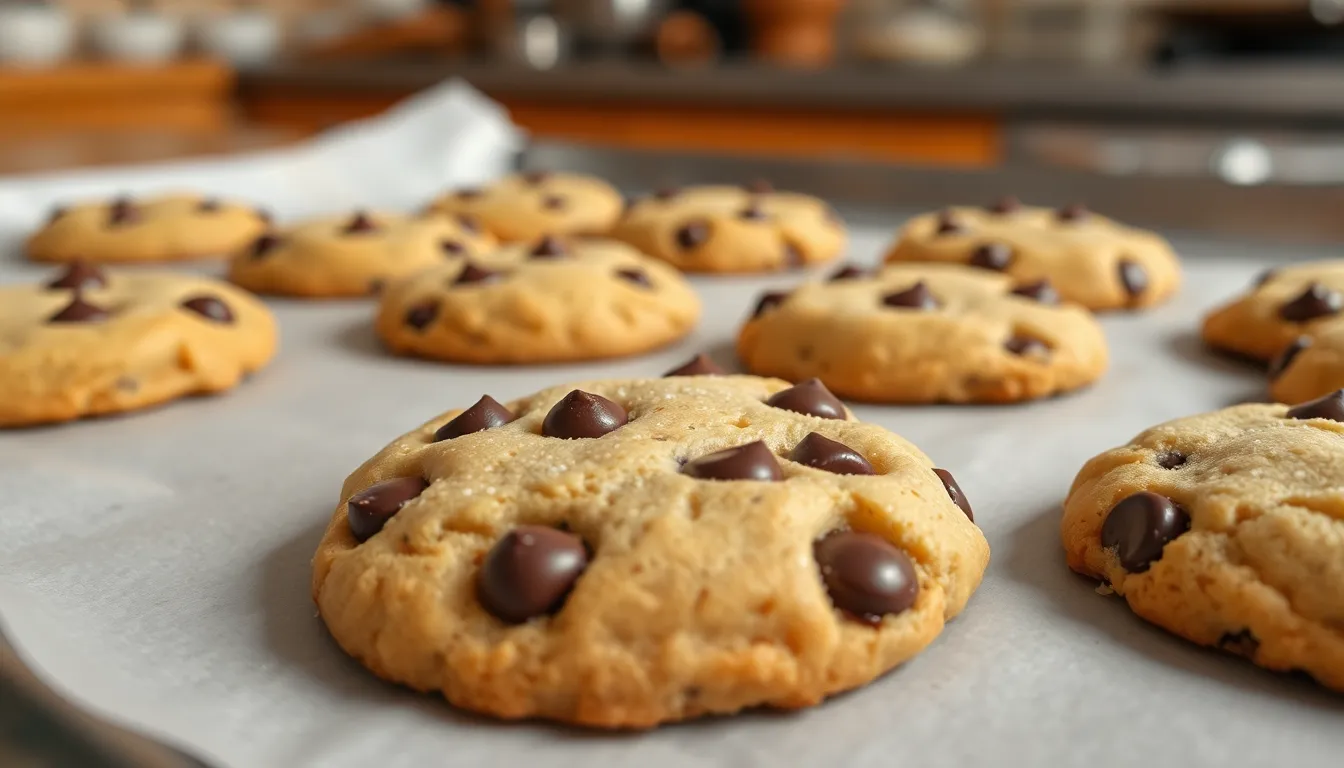
We’ve mastered the basic technique for our eggless chocolate chip cookies. Now let’s focus on the critical details that transform good cookies into extraordinary ones.
Achieving the Right Texture
We recommend sticking with all-purpose flour for the lightest and softest texture in our eggless cookies. Whole wheat flour creates a denser cookie with a coarse texture that can overpower the delicate balance we’re seeking. Our cornstarch and water mixture serves as more than just an egg substitute—it helps maintain the cookies’ shape and provides the binding power needed for that perfect chewy center.
Room temperature ingredients are non-negotiable for optimal texture. We always ensure our butter is softened but not melted, and our milk should be at room temperature for seamless incorporation. When we combine our wet and dry ingredients, we mix until just combined to avoid developing tough, overdone cookies.
Preventing Spreading
We control cookie spread through strategic ingredient preparation and dough handling. Our combination of brown and white sugar maintains moisture while providing the structure needed to prevent excessive spreading. The butter temperature is crucial—we want it softened enough to cream easily but firm enough to hold its shape.
If our dough feels too soft after mixing, we can chill it briefly, though most eggless cookie recipes don’t require this step. We space our cookie dough balls adequately on parchment-lined baking sheets to allow for natural spreading without overcrowding.
Testing for Doneness
We look for lightly browned edges and set centers to determine when our cookies are perfectly baked. This typically occurs after 10 to 15 minutes at 350°F, depending on cookie size. The centers should appear slightly underbaked when we remove them from the oven, as they’ll continue cooking on the hot baking sheet.
We resist the urge to overbake our cookies, as eggless varieties can become dry quickly. Quality chocolate chips—whether dark or semi-sweet—will hold their shape and provide the flavor depth that signals our cookies are ready to enjoy.
Storage Instructions
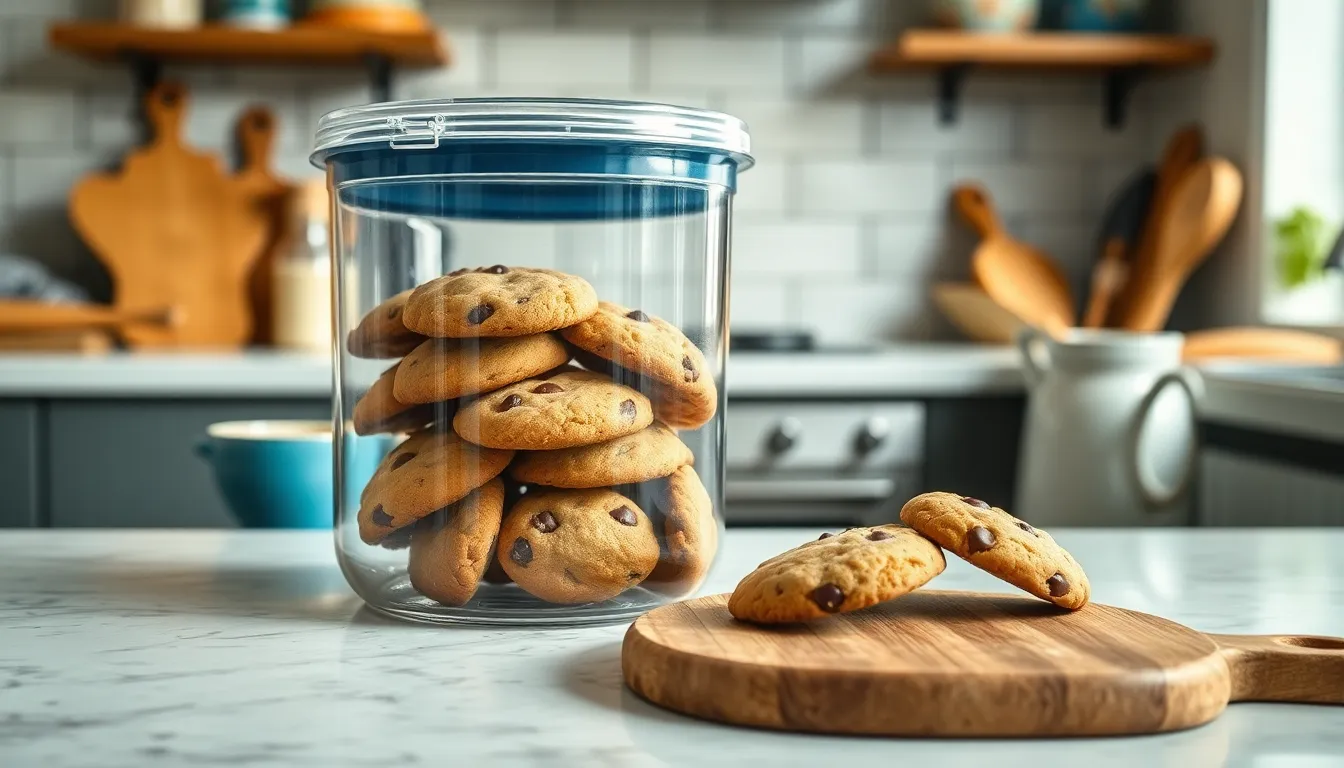
Proper storage keeps our eggless chocolate chip cookies fresh and delicious for days or even weeks. We’ll share the best methods to maintain their perfect chewy texture and rich flavor.
Short-term Storage
We can store our freshly baked eggless chocolate chip cookies at room temperature in an airtight container. The storage duration depends on our exact recipe and desired freshness level.
| Storage Method | Duration | Container Type |
|---|---|---|
| Room Temperature | 2-3 days | Airtight container |
| Room Temperature | 5-6 days | Airtight container |
| Room Temperature | Up to 1 week | Airtight container |
Our cookie dough also stores well for short periods. We wrap the dough in plastic wrap or place it in an airtight container before refrigerating. This method allows us to bake fresh cookies whenever we want them.
Room temperature storage works best when we ensure our cookies are completely cooled before sealing them. Warm cookies create condensation inside containers which leads to soggy textures we want to avoid.
Long-term Storage
Freezing extends our cookie storage significantly beyond room temperature options. We can freeze both baked cookies and unbaked cookie dough with excellent results.
Our baked cookies freeze beautifully in airtight containers for up to 30 days. We thaw frozen cookies at room temperature for 1-2 hours before serving to restore their original texture and flavor.
Cookie dough balls freeze exceptionally well using a simple two-step process. We place shaped dough balls on parchment-lined baking sheets until they freeze solid. Then we transfer the frozen balls to ziplock bags or airtight containers for space-efficient storage.
Baking frozen cookie dough requires minimal adjustments to our original recipe. We place frozen dough balls directly on our baking sheets after preheating the oven. The frozen dough may need a few extra minutes of baking time compared to fresh dough to achieve the same golden brown edges and set centers.
Make-Ahead Tips
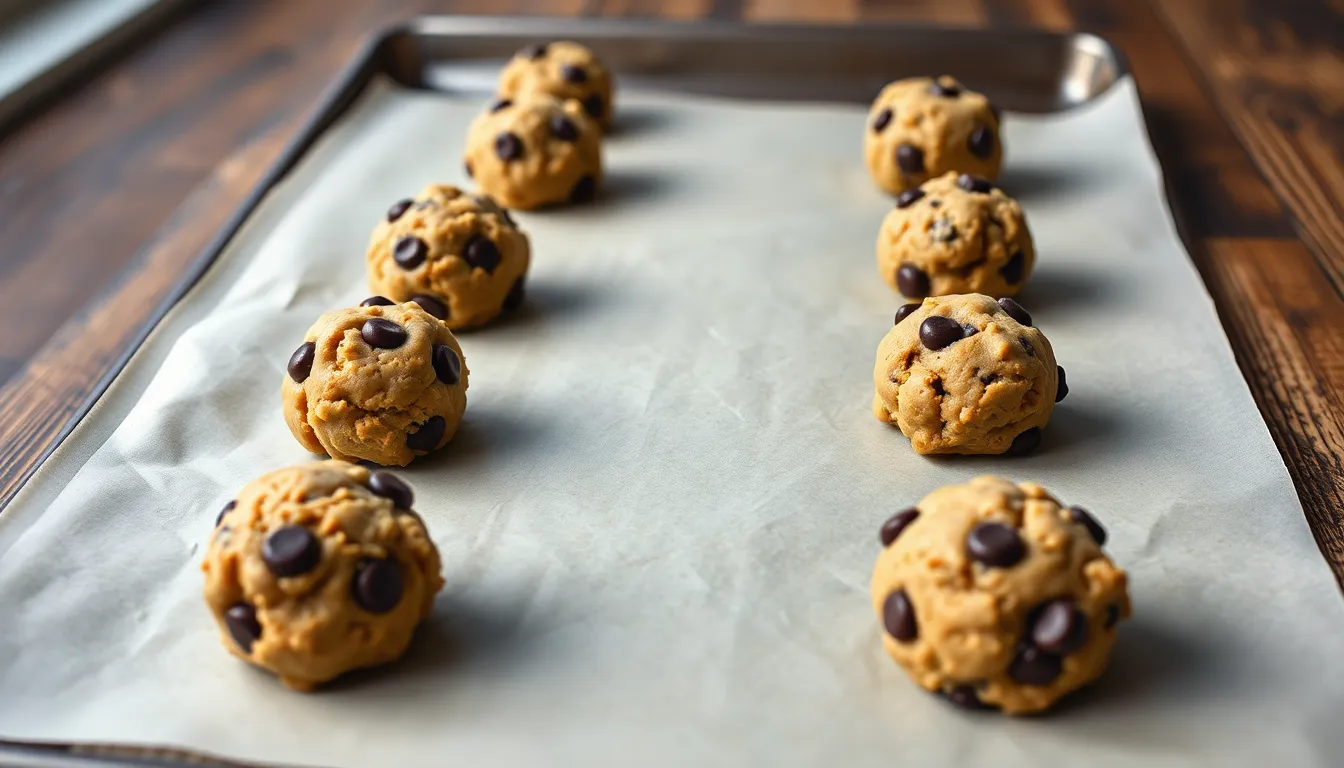
Planning ahead transforms cookie baking from a time-consuming process into a quick treat whenever cravings strike. We’ve discovered several effective strategies that make our eggless chocolate chip cookies even more convenient to prepare.
Chilling the Dough for Better Results
Refrigerating the dough for at least one hour dramatically improves both texture and flavor. This chilling period allows the flour to fully hydrate while enabling more pronounced browning reactions during baking. We notice the cookies develop deeper flavors and achieve that perfect chewy texture when we take this extra step.
Freezing Cookie Dough
Our cookie dough freezes beautifully for up to three months without compromising quality. Shape the dough into individual cookie balls and place them on a parchment-lined baking sheet. Freeze the shaped dough for two hours until solid then transfer the frozen balls to an airtight container or freezer bag.
| Storage Method | Duration | Temperature | Notes |
|---|---|---|---|
| Frozen Dough Balls | Up to 3 months | 0°F | Bake directly from frozen |
| Refrigerated Dough | Up to 5 days | 35-40°F | Best texture after 1+ hours |
Baking from Frozen
Baking frozen cookie dough requires minimal adjustments to our original recipe. Preheat the oven to 350°F and place frozen dough balls directly on parchment-lined baking sheets. Bake for 13 to 15 minutes until the edges turn golden brown. The slightly extended baking time ensures the centers cook through completely while maintaining that desirable soft texture.
Storage Answers for Baked Cookies
Properly stored baked cookies maintain their freshness for up to five days at room temperature in an airtight container. For longer storage we recommend freezing baked cookies for up to 30 days. Layer the cookies between parchment paper in freezer-safe containers to prevent sticking and preserve their shape.
Troubleshooting Common Issues
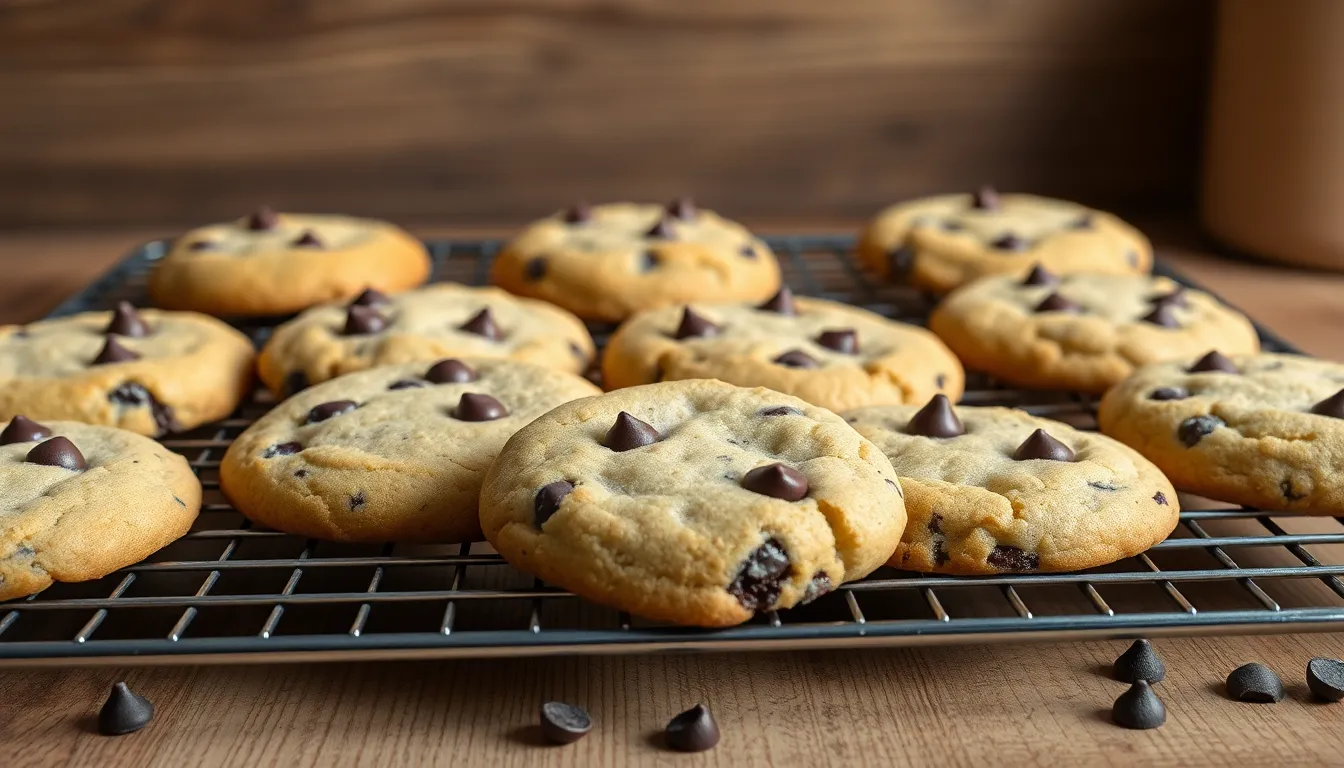
Cookie Texture Problems
Cookies spread too much during baking: We recommend chilling your dough for at least one hour before baking. Unchilled dough leads to flatter cookies with coarser texture and less browning. Room temperature dough spreads excessively in the oven while chilled dough maintains better shape and creates thicker, chewier cookies.
Cookies turn out too thick or crumbly: Accurate flour measurement prevents this common issue. Too much flour creates thick, crumbly, or doughy cookies that lack the desired texture. We suggest using the spoon-and-level method rather than scooping directly from the container to avoid packing excess flour.
Cookies are too soft or greasy: This problem typically stems from insufficient flour in your recipe. Too little flour causes overly soft, greasy cookies that spread excessively during baking. Adding cornstarch to your recipe helps keep eggless chocolate chip cookies soft rather than crunchy while maintaining proper structure.
Sugar and Sweetness Issues
Cookies lack flavor depth: We recommend using a higher ratio of brown sugar to granulated sugar for enhanced flavor and chewiness. Dark brown sugar provides more molasses content, which contributes to richness and creates a soft texture that compensates for the absence of eggs.
Sugar doesn’t cream properly with butter: Caster sugar dissolves more easily when creamed with butter and aids in proper cookie structure. Granulated sugar proves less suitable for achieving smooth creaming, which can affect your final cookie texture.
Browning and Development Problems
Cookies don’t brown properly: Baking soda helps with spreading, browning, and flavor development in eggless cookies. Its alkaline nature encourages Maillard browning and flavor enhancement, which can be hindered by the absence of egg proteins. We ensure our recipe includes adequate baking soda for optimal results.
Cookies lack binding: Common egg substitutes like melted butter, yogurt, or our recommended mixture of cornstarch with water replicate the binding and moisture functions that eggs typically provide. Our cornstarch mixture effectively holds ingredients together while maintaining proper cookie structure.
Timing and Temperature Concerns
Cookies are underbaked or overbaked: We bake our cookies at 350°F (175°C) for 10-12 minutes. Cookies finish baking when edges appear lightly browned and centers remain set but still soft to touch. Overbaking creates dry, hard cookies while underbaking results in raw centers.
Dough doesn’t develop flavor: Letting your dough rest before baking allows ingredients to meld and improves overall texture. This hydration time helps flour absorb moisture and creates better cookie structure. We allow our dough to cool on the baking sheet for 5 minutes before transferring to a wire rack for complete cooling.
Variations and Substitutions
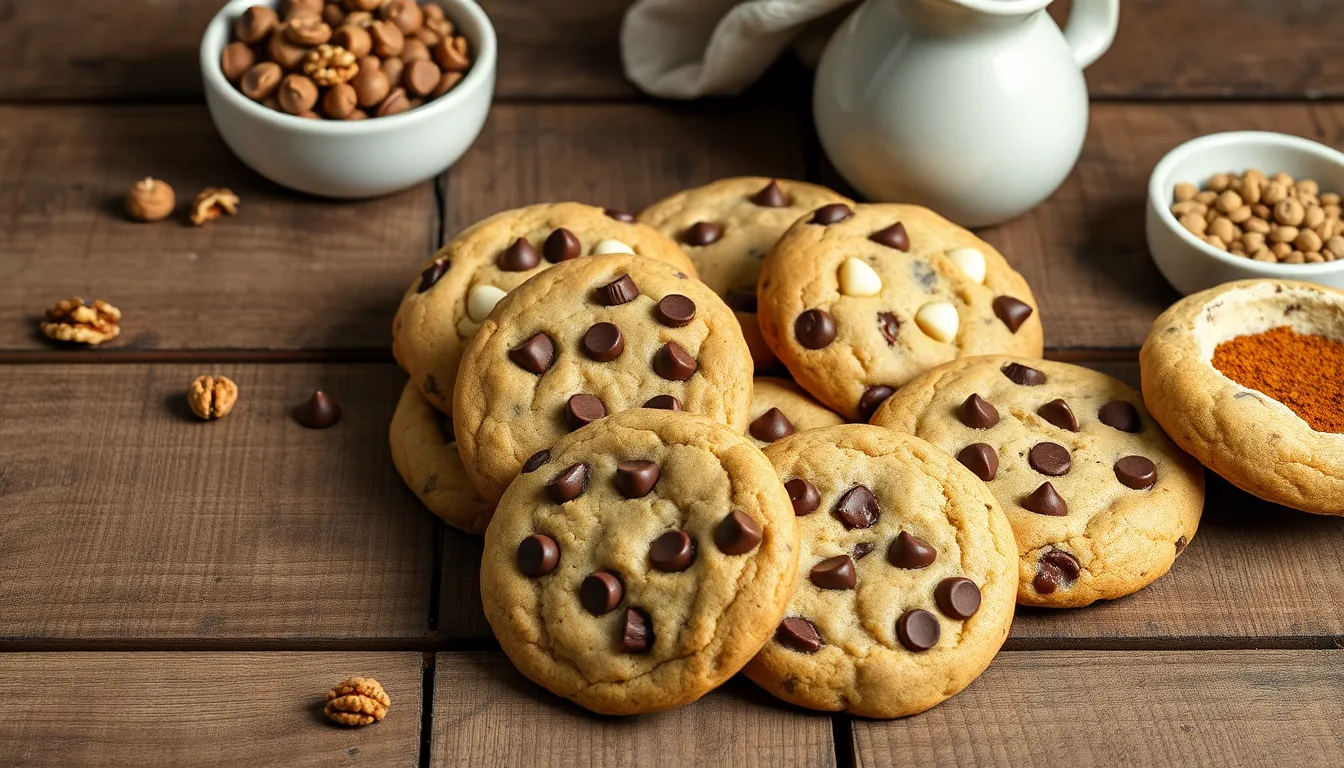
Customizing your eggless chocolate chip cookies allows you to cater to different dietary needs and taste preferences. We can transform the basic recipe using various ingredient swaps without compromising the delicious results.
Flour Alternatives
All-purpose flour serves as our standard base for achieving the perfect light texture in eggless chocolate chip cookies. Whole wheat flour offers added nutritional value when you want to boost the fiber content of your cookies. Oat flour creates a slightly denser texture while providing extra nutrients and a subtle nutty flavor.
Gluten-free bakers can successfully use almond flour for a rich, nutty taste and tender crumb. Rice flour works well as another gluten-free option, producing cookies with a more traditional texture. When substituting gluten-free flours, we recommend using a 1:1 ratio but expect slight texture variations from the original recipe.
Chocolate Chip Options
Semi-sweet chocolate chips remain the most popular choice, delivering that classic rich chocolate flavor we all love. These chips provide the perfect balance of sweetness without overwhelming the cookie’s buttery base.
Dark chocolate chips elevate the recipe with their deeper, more intense chocolate taste. They work especially well when you prefer less sweetness and want to highlight the chocolate’s complexity. White chocolate chips create a sweeter and lighter flavor profile, making them ideal for those who enjoy milder chocolate notes.
Mini chocolate chips distribute more evenly throughout the dough, ensuring every bite contains chocolate. Chocolate chunks add rustic appeal and create pockets of melted chocolate that enhance the overall eating experience.
Flavor Variations
Walnuts and pecans enhance both texture and flavor when folded into the cookie dough. These nuts provide a satisfying crunch that contrasts beautifully with the soft cookie base. We recommend roughly chopping them to prevent overwhelming the other ingredients.
Spices like cinnamon and nutmeg add warmth and complexity to your cookies. A pinch of either spice transforms the basic recipe into something uniquely aromatic. Start with small amounts since these spices can quickly overpower the chocolate flavor.
Espresso powder amplifies the chocolate taste without making the cookies coffee-flavored. Adding just one teaspoon creates depth and richness that makes the chocolate chips taste more intense. This addition works particularly well with dark chocolate chips for an sophisticated flavor profile.
Conclusion
We’ve shown you that creating exceptional eggless chocolate chip cookies isn’t just possible—it’s incredibly rewarding. These cookies deliver the same beloved taste and texture you’d expect from traditional recipes while accommodating various dietary needs and preferences.
The beauty of this recipe lies in its simplicity and reliability. With basic pantry ingredients and our tested techniques you’ll consistently achieve that perfect balance of crispy edges and chewy centers that makes these cookies irresistible.
Whether you’re baking for someone with allergies sharing with vegan friends or simply ran out of eggs these cookies prove that great baking doesn’t require compromise. Every bite delivers the classic chocolate chip cookie experience we all crave—no one will ever guess they’re eggless.
Frequently Asked Questions
Can I make chocolate chip cookies without eggs?
Yes, you can make delicious chocolate chip cookies without eggs! This recipe uses a clever combination of cornstarch and water as an egg substitute, along with milk and butter for binding. The result is chewy cookies with crispy edges that taste just as good as traditional recipes.
What ingredients do I need for eggless chocolate chip cookies?
You’ll need 2¼ cups all-purpose flour, 1 tsp baking soda, 1 tsp salt, ½ cup granulated sugar, ¾ cup brown sugar, 1 cup softened butter, ¼ cup milk, 2 tbsp cornstarch mixed with 3 tbsp water, 2 tsp vanilla extract, and 2 cups chocolate chips.
How long do eggless chocolate chip cookies take to make?
These eggless chocolate chip cookies take only 30 minutes total to prepare and bake. The prep time is about 15-20 minutes for mixing the dough, and baking takes 10-12 minutes per batch at the proper temperature.
What can I use instead of eggs in chocolate chip cookies?
The best egg substitute for these cookies is a mixture of 2 tablespoons cornstarch mixed with 3 tablespoons water. This combination provides the binding properties that eggs typically offer, helping create the perfect chewy texture without compromising flavor.
How do I store eggless chocolate chip cookies?
Store baked cookies in an airtight container at room temperature for 2-3 days for optimal freshness, or up to one week. For longer storage, freeze baked cookies for up to 30 days or freeze unbaked cookie dough balls for up to three months.
Why are my eggless cookies spreading too much?
Excessive spreading usually occurs when butter is too warm or dough isn’t chilled. Ensure butter is softened but not melted, chill the dough for at least one hour before baking, and make sure your baking sheets aren’t too warm between batches.
Can I make the cookie dough ahead of time?
Yes! You can refrigerate the dough for up to one week or freeze shaped cookie balls for up to three months. Chilling the dough for at least one hour actually improves texture and flavor, making it an excellent make-ahead option.
What equipment do I need to make eggless chocolate chip cookies?
Essential equipment includes a large mixing bowl, whisk, spatula, heavy-duty baking sheets, parchment paper, and a cookie scoop for uniform portions. An electric mixer is helpful for creaming butter and sugars, but hand mixing works too.
Can I substitute different types of flour in this recipe?
Yes, you can use whole wheat flour for a heartier texture or gluten-free alternatives like almond flour or rice flour. However, different flours may affect texture and baking time, so you may need to adjust liquid ingredients accordingly.
How do I know when eggless chocolate chip cookies are done?
Look for lightly golden brown edges and set centers. The cookies should appear slightly underbaked in the center when removed from the oven, as they’ll continue cooking on the hot baking sheet. Avoid overbaking to prevent dryness.

